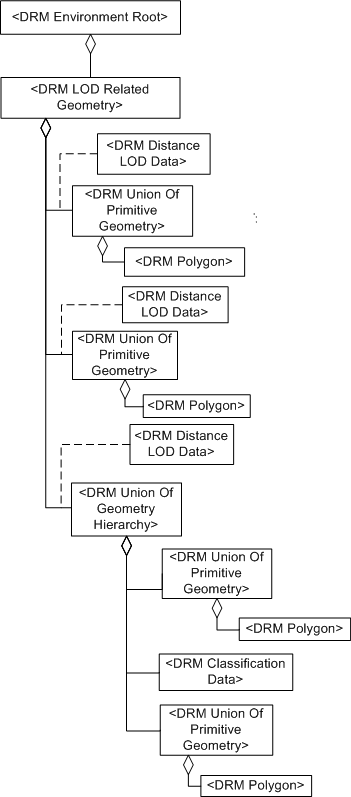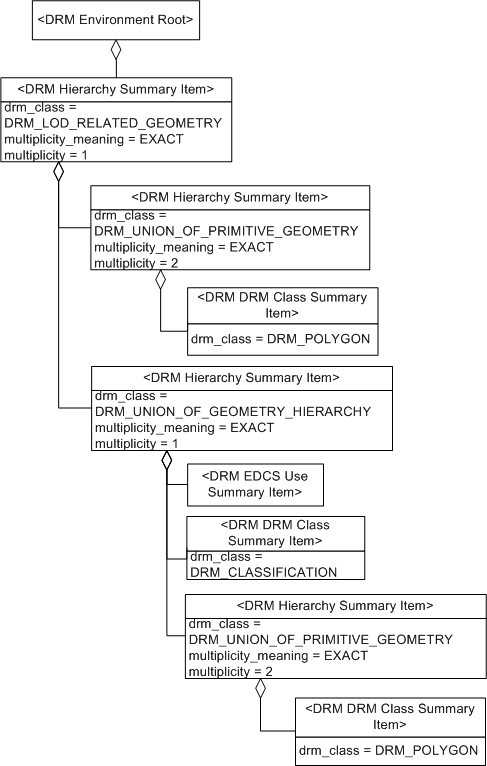Class Name: Hierarchy Summary Item
Subclasses
This DRM class is concrete and has no subclasses.
Definition
An instance of this DRM class represents an instance, or a number of
identical instances, of a <Geometry Hierarchy> instance or
<Feature Hierarchy> instance that exists within the
given <Model> instance or <Environment Root>
instance. <Hierarchy Summary Item> instances are combined
together to form hierarchies that mirror those that they summarize.
This summary is a compressed form of the actual hierarchy, as each
<Hierarchy Summary Item> instance may represent a number of
instances of the class indicated by its
drm_class field.
The multiplicity field records how many
instances of the given class a <Hierarchy Summary Item> instance
actually represents. All instances represented by one
<Hierarchy Summary Item> instance shall have exactly the same
hierarchical pattern beneath them, right down to where the
hierarchy summary concludes. A <Hierarchy Summary Item> instance
represents both the instance(s) that it describes, and the specific
hierarchy beneath it. It may have an optional association to the
<Geometry Hierarchy> instance(s) or
<Feature Hierarchy> instance(s) that it summarizes.
Each <Hierarchy Summary Item> instance can optionally have a
list of <EDCS Use Summary Item> components giving the
classifications that are attached to those instances in the transmittal
being summarized.
The hierarchy summary does not have to be a total representation of the
entire transmittal hierarchy and can be limited to a useful high level
summary.
If the producer of the transmittal being summarized deems it of
potential use to consumers, the branches of the hierarchy summary
can terminate with a list of
<DRM Class Summary Item> components
representing the DRM objects beneath that point in the hierarchy.
Primary Page in DRM Diagram:
Secondary Pages in DRM Diagram:
Example
Consider an <Environment Root> instance for which the
geometry is to be summarized.

Figure 21 — <DRM Hierarchy Summary Item> example associated <DRM Environment Root>
The geometry portion of the above <Environment Root> instance
can therefore be summarized as follows. Note that this is the same
<Environment Root> instance
as shown above, but for readability only the
<Hierarchy Summary Item> component tree portion
of its instance diagram is shown here.

Figure 22 — <DRM Hierarchy Summary Item> example
The <Hierarchy Summary Item> component tree depicted in
Figure 22, rooted at the <Environment Root> instance
depicted in Figure 21,
parallels the structure of the corresponding geometry. In this instance,
the data provider has elected not to provide a detailed summary of the
structure of the <Union Of Geometry Hierarchy> instance.
The list of <DRM Class Summary Item> components
merely identify classes that are somewhere below the
<Union Of Geometry Hierarchy> instance, rather than the
patterns in which they appear.
The <EDCS Use Summary Item> components summarize patterns of
ECCs, possibly used together with EACs, in the context being summarized.
If the data provider wished to summarize the hierarchy of the
<Union Of Geometry Hierarchy> instance in detail, its
<Hierarchy Summary Item> instance could be provided with
appropriate <Hierarchy Summary Item> components as desired,
until the summary reached the level of <Primitive Geometry>
instances and the hierarchy summary came to an end.
For examples of summaries of <Primitive Geometry> patterns,
see <Primitive Summary Item>.
FAQs
-
If the intent is for a useful high level summary, why not just have
the consumer perform a shallow breadth-first search?
The consumer could indeed compute the information, since all that
this provides is a summary of what is in the transmittal. The reason
for providing the information is to indicate that users do not have
to be exhaustive if they do not think it is appropriate / required /
necessary, or a good use of processing time, etc. Even just providing
a top level summary, allows producers to summarize. They do not have
to be complete in a legalistic way, and can therefore use this mechanism
to summarize the major hierarchical structuring, perhaps leaving out
less significant deviations from that predominant pattern. These
would turn up in a search and actually confuse the issue. If you
like, this mechanism allows a producer to sketch out the forest
without missing it for the trees.
-
Why can <Environment Root> and
<Model> only have 0 - 2
<Hierarchy Summary Item>
components?
See
<<Hierarchy Summary Constraints>>.
Constraints
Associated to (one-way)
Composed of (two-way)
Composed of (two-way metadata) (inherited)
Component of (two-way)
Notes
Associated to Notes
If present, the association(s) to <Feature Hierarchy>
instances indicate that the <Hierarchy Summary Item>
instance summarizes the specific <Feature Hierarchy>
object tree(s) thus indicated.
If present, the association(s) to <Geometry Hierarchy>
instances indicate that the <Hierarchy Summary Item>
instance summarizes the specific <Geometry Hierarchy>
object tree(s) thus indicated.
Composed of Notes
If present, the list of
<EDCS Use Summary Item> components
of a <Base Summary Item> instance
summarize EDCS usage by instances
of the class specified by
drm_class that occur
somewhere in the scope being summarized.
If present, the <DRM Class Summary Item> components of a
<Hierarchy Summary Item> instance list classes for which
instances occur beneath this point in the hierarchy being summarized.
If present, the <Hierarchy Summary Item> components of a
<Hierarchy Summary Item> instance summarize the next
level down in the component tree of the hierarchy being summarized.
Fields Notes
The drm_class
field indicates the DRM class of the DRM object(s)
represented by the
<Base Summary Item> instance.
The multiplicity_meaning field
specifies the meaning of the
multiplicity field value for the
<Hierarchy Summary Item> instance.
The multiplicity
field specifies the number of identical instances represented,
or the order of magnitude of that number, for the
<Hierarchy Summary Item>
instance. If the multiplicity is unknown, the value of this
field shall be set to zero.
Prev: Hierarchy Data.
Next: HSV Colour.
Up:Index.

